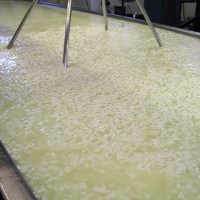Whey turned into biodegradable products

People consume a lot of cheese, and the cheese making process produces whey. Whey is used in a range of products such as candy, pasta, baked goods, animal feed and even pharmaceuticals. New research shows that whey can also be used to create eco-friendly products.
ARS’s Dairy Processing and Products Research Unit at the Eastern Regional Research Center (ERRC) in Wyndmoor, Pennsylvania, has investigated uses for whey and other dairy byproducts and showed that whey can also be used to create eco-friendly products. For example, using a process called “reactive extrusion,” food technologist Charles Onwulata supplements polyethylene—a common nonbiodegradable plastic—with whey proteins.
Biodegradable plastic
Reactive extrusion involves forcing plastic material through a heating chamber, where it melts and combines with a chemical agent that strengthens it before it’s molded into a new shape. Onwulata showed that by combining dairy proteins with starch during this process, it’s possible to create a biodegradable plastic product that can be mixed with polyethylene and molded into utensils.
Working with laboratory chief Seiichiro Isobe, of the Japanese National Food Research Institute, Onwulata created a bioplastic blend by combining whey protein isolate, cornstarch, glycerol, cellulose fiber, acetic acid, and the milk protein casein and molded the material into cups. Onwulata observed that dairy-based bioplastics were more pliable than other bioplastics, making them easier to mold.
Bioplastic blends can replace only about 20% of the polyethylene in a product, so resulting materials are only partially biodegradable. But Onwulata and his colleagues are currently applying this process to polylactide (PLA), a biodegradable polymer.
Edible coatings
In a separate project, research leader Peggy Tomasula and her colleagues have developed technology to create biodegradable films from byproducts of both dairy processing and biofuels production. Tomasula found that combining casein with water and glycerol—a byproduct of biodiesel production—produces a water-resistant film that can be used as an edible coating for groceries and other products.
“We use carbon dioxide as an environmentally friendly solvent to isolate dairy proteins from milk, instead of harsh chemicals or acids, which can be difficult to dispose of,” Tomasula says. Carbon dioxide is a byproduct of the glucose fermentation that is used to make ethanol, and she says it makes the edible film more water resistant. The resulting food coatings are glossy, transparent, and completely edible. Like traditional food packaging, edible films can extend the shelf life of many foods, protect products from damage, prevent exposure to moisture and oxygen, and improve appearance. By using renewable resources instead of petrochemicals, the scientists can create more biodegradable products and reduce waste.
Join 26,000+ subscribers
Subscribe to our newsletter to stay updated about all the need-to-know content in the feed sector, three times a week. Beheer
Beheer









 WP Admin
WP Admin  Bewerk bericht
Bewerk bericht